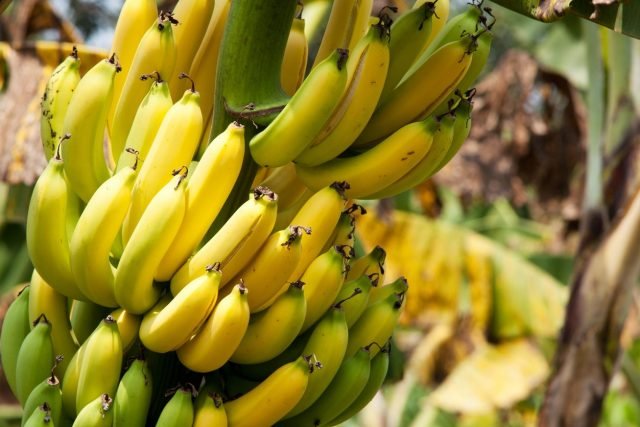
Banana farming in Nigeria is one of the agribusiness that contributes to the food and economic value of the country. Banana farming is the cultivation of the banana crop for consumption and industrial use. Banana fruit varies in color, sizes and firmness, but is usually elongated and curved with a soft flesh rich in starch and covered with a rind, which may be green, yellow or red when ripe.
Banana is a delicious fruit that contains lots of nutrients to boost the immune system and also improves fertility. Banana is highly craved because of its health benefits and taste. Banana farming in Nigeria requires less labour, inputs and capital than most other crops, and its market is huge and readily available.
Banana has various ways it can be utilized which include: food, beverages (soft and alcoholic) snacks, feed, industrial ethanol, and medicinal potency. Studies have revealed that banana is the cheapest form of carbohydrate to produce and they are able to grow in a wide range of environments. Nigeria banana market is largely underutilized.
Now, let us consider the ecological requirement and management of banana farming in Nigeria.
STARTING A LUCRATIVE BANANA FARMING
LAND SELECTION
Bananas can be grown in a wide range of soils as long as there is good drainage and adequate fertility. Bananas can tolerate short periods of flooding but do require good soil aeration. Light to medium, well drained loam soil is the best for banana cultivation, soils rich in organic matter with moderate soil moisture. A pH range of 5.5 to 6.5 is recommended for best growth. Bananas needs an adequate supply of potassium, nitrogen, magnesium, calcium and phosphorus.
LAND PREPARATION
In banana farming, it very paramount that the land be slashed and prepared with burning to protect organic matter. Manual clearing should be preferred to mechanized clearing because the machinery used always remove the top soil which contains the organic matters essential for the plant growth.
SELECTING SUCKER FOR PLANTING
To succeed in banana farming, having the right sucker is necessary. Plantains and bananas are not grown like other plants. They are grown through suckers. Banana suckers (small shoot from the base of a banana plant) are usually acquired from another grower or plant nursery.
Clean, healthy sucker which consists of side shoots, or pieces of corm with one to two eyes should be selected. Always remember the larger the sucker, the faster the plants will come into production. Also defoliate the banana suckers before planting.
PLANTING
There’s always the best season to farm and in banana farming, the rules are the same. The best time for planting banana is at the beginning of the rainy season, holes should be at least 60cm in diameter and 60cm deep. Half fill the top soil mixed with manure/fertilizer before planting the suckers.
PLANTING SPACE
The plant spacing depends on the banana variety, but on the average spacing is 3m×3m.
MULCHING
To be a successful banana farmer, you have to take mulching seriously because it minimizes the loss of water. Banana needs heavy mulching so as to suppress unwanted weed growth, retain moisture and provide humus for good soil structure. Banana leaves, grass, rice husk or old stems mulch can be used to retain nutrients in the soil.
DESUCKERING
This involves removing of excess suckers from a banana tree, so as to have bigger and quality bunches and to also maintain proper spacing. Surplus suckers should be removed and used as planting material.
WEED CONTROL
Weeding is done to prevent your banana from undertaking in an unnecessary competition with the weeds and because of that, they have to be sprouted out of the farm. Weed infestation can cause a drop in banana yield. Therefore weeds should be controlled either mechanically or by the use of herbicides.
FERTILIZER APPLICATION
For adequate yield, banana will benefits from farm yard manure, so as to provide suitable organic matter necessary for the growth of the sucker and to ensure a good yield. Organic fertilizer made up of livestock manure, household waste and wood ash improves banana growth, yield and greatly reduce the effect of borer weevils and nematodes.
STAKING
Bananas are highly susceptible to heavy winds, banana trees should be staked to provide extra support to the banana stems. Also banana cultivars that bear very big bunches are very susceptible to heavy winds. Banana staking is done with a forked pole.
HARVESTING
The maturity period of a banana depends on area and variety. Banana takes roughly 8-12months to mature.
Bananas are harvested green at varying stages of maturity depending on the market requirement while harvesting bananas, bunches should not be allowed to fall carelessly on the ground after cutting from the plant, so as to avoid damaging the fruit.
Harvested bananas must be transported to the market while green, so as avoid post-harvest losses.
SUCCESS TIPS
Having a banana farming business plan widens your chances of succeeding in this agribusiness.
Employing workers makes the whole farming experience fun and accelerate growth and expansion
More land means more input and more input means more output.
Joining relevant farmers association is also a good choice for every determined farmer
Diversifying into plantain farming is a common practice and you should to, to create more streams of income.